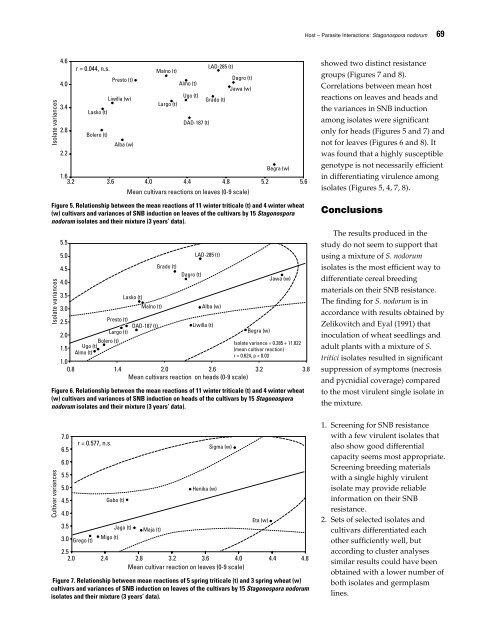Septoria and Stagonospora Diseases of Cereals - CIMMYT ...
Septoria and Stagonospora Diseases of Cereals - CIMMYT ...
Septoria and Stagonospora Diseases of Cereals - CIMMYT ...
You also want an ePaper? Increase the reach of your titles
YUMPU automatically turns print PDFs into web optimized ePapers that Google loves.
Isolate variances<br />
Isolate variances<br />
4.6<br />
4.0<br />
3.4<br />
2.8<br />
2.2<br />
1.6<br />
3.2 3.6 4.0 4.4 4.8 5.2 5.6<br />
Mean cultivars reactions on leaves (0-9 scale)<br />
Figure 5. Relationship between the mean reactions <strong>of</strong> 11 winter triticale (t) <strong>and</strong> 4 winter wheat<br />
(w) cultivars <strong>and</strong> variances <strong>of</strong> SNB induction on leaves <strong>of</strong> the cultivars by 15 <strong>Stagonospora</strong><br />
nodorum isolates <strong>and</strong> their mixture (3 years’ data).<br />
5.5<br />
5.0<br />
4.5<br />
4.0<br />
3.5<br />
3.0<br />
2.5<br />
2.0<br />
1.5<br />
r = 0.044, n.s.<br />
Lasko (t)<br />
Bolero (t)<br />
Presto (t)<br />
Largo (t)<br />
Bolero (t)<br />
Ugo (t)<br />
Almo (t)<br />
Presto (t)<br />
Liwilla (w)<br />
Alba (w)<br />
Lasko (t)<br />
Malno (t)<br />
DAD-187 (t)<br />
Malno (t)<br />
Almo (t)<br />
Largo (t)<br />
Grado (t)<br />
Ugo (t)<br />
DAD-187 (t)<br />
Dagro (t)<br />
LAD-285 (t)<br />
Alba (w)<br />
Liwilla (t)<br />
LAD-285 (t)<br />
Dagro (t)<br />
Jawa (w)<br />
Grado (t)<br />
Begra (w)<br />
Begra (w)<br />
Jawa (w)<br />
Isolate variance = 0.285 + 11.022<br />
(mean cultivar reaction)<br />
r = 0.624, p < 0.03<br />
1.0<br />
0.8 1.4 2.0 2.6 3.2 3.8<br />
Mean cultivars reaction on heads (0-9 scale)<br />
Figure 6. Relationship between the mean reactions <strong>of</strong> 11 winter triticale (t) <strong>and</strong> 4 winter wheat<br />
(w) cultivars <strong>and</strong> variances <strong>of</strong> SNB induction on heads <strong>of</strong> the cultivars by 15 <strong>Stagonospora</strong><br />
nodorum isolates <strong>and</strong> their mixture (3 years’ data).<br />
Cultivar variances<br />
7.0<br />
6.5<br />
6.0<br />
5.5<br />
r = 0.577, n.s.<br />
Sigma (w)<br />
5.0<br />
Henika (w)<br />
4.5<br />
4.0<br />
Gabo (t)<br />
Eta (w)<br />
3.5<br />
Jago (t) Maja (t)<br />
3.0 Grego (t)<br />
Migo (t)<br />
2.5<br />
2.0 2.4 2.8 3.2 3.6 4.0 4.4 4.8<br />
Mean cultivar reaction on leaves (0-9 scale)<br />
Figure 7. Relationship between mean reactions <strong>of</strong> 5 spring triticale (t) <strong>and</strong> 3 spring wheat (w)<br />
cultivars <strong>and</strong> variances <strong>of</strong> SNB induction on leaves <strong>of</strong> the cultivars by 15 <strong>Stagonospora</strong> nodorum<br />
isolates <strong>and</strong> their mixture (3 years’ data).<br />
Host – Parasite Interactions: <strong>Stagonospora</strong> nodorum 69<br />
showed two distinct resistance<br />
groups (Figures 7 <strong>and</strong> 8).<br />
Correlations between mean host<br />
reactions on leaves <strong>and</strong> heads <strong>and</strong><br />
the variances in SNB induction<br />
among isolates were significant<br />
only for heads (Figures 5 <strong>and</strong> 7) <strong>and</strong><br />
not for leaves (Figures 6 <strong>and</strong> 8). It<br />
was found that a highly susceptible<br />
genotype is not necessarily efficient<br />
in differentiating virulence among<br />
isolates (Figures 5, 4, 7, 8).<br />
Conclusions<br />
The results produced in the<br />
study do not seem to support that<br />
using a mixture <strong>of</strong> S. nodorum<br />
isolates is the most efficient way to<br />
differentiate cereal breeding<br />
materials on their SNB resistance.<br />
The finding for S. nodorum is in<br />
accordance with results obtained by<br />
Zelikovitch <strong>and</strong> Eyal (1991) that<br />
inoculation <strong>of</strong> wheat seedlings <strong>and</strong><br />
adult plants with a mixture <strong>of</strong> S.<br />
tritici isolates resulted in significant<br />
suppression <strong>of</strong> symptoms (necrosis<br />
<strong>and</strong> pycnidial coverage) compared<br />
to the most virulent single isolate in<br />
the mixture.<br />
1. Screening for SNB resistance<br />
with a few virulent isolates that<br />
also show good differential<br />
capacity seems most appropriate.<br />
Screening breeding materials<br />
with a single highly virulent<br />
isolate may provide reliable<br />
information on their SNB<br />
resistance.<br />
2. Sets <strong>of</strong> selected isolates <strong>and</strong><br />
cultivars differentiated each<br />
other sufficiently well, but<br />
according to cluster analyses<br />
similar results could have been<br />
obtained with a lower number <strong>of</strong><br />
both isolates <strong>and</strong> germplasm<br />
lines.









